Part 1: Nicely done!
The first ever ATP Tour Event in Istanbul, Turkey, officially named TEB BNP Paribas Istanbul Open, not that anybody will ever bother using its full name, kicked off at Garanti Koza Arena on Saturday with qualifying round matches. The excitement created around this tournament is tremendous, mainly because of the appeal of one of the world’s most popular athletes, Roger Federer. If there are any studies centering on how a celebrity name can impact the attention drawn to an event, Istanbul Open should earn a chapter in that study all by itself. To illustrate, when tournament organizers announced, with wide smiles on their faces, few weeks ago that Federer would participate to the tournament, they had no idea that tickets for all sessions and seats would sell out in less than two hours. Federer’s arrival to the airport on Sunday was broadcast live on TV by one of the leading sports channels, as well as his first practice that afternoon (more on that below). His first press conference on Monday afternoon was held not at the tournament site, but at the plush Four Seasons Hotel, located a considerable distance from the tournament site.
The organizers did not stop there and they also convinced Grigor Dimitrov to come. For the inaugural session of an ATP 250 level event that is scheduled the week preceding two successive ATP 1000 Masters tournaments (Madrid, Rome), this is a tremendous achievement. Add clay-court specialists Pablo Cuevas (no.23), Santiago Giraldo (no.37), and Andreas Haider-Maurer (no.47) to the rest of the participants such as Mikhail Youzhny, Jarkko Nieminen, and local favorite Marsel Ilhan, and you have a very solid ATP 250 draw with one marquee name, one star player, and bunch of established top-50 names. Attracting high-level competitors was probably the area where the tournament organizers had the most success.
As a result, Turkish tennis fans are upbeat and those that came to watch the qualifying round matches yesterday (entrance was free!) were treated to a surprise. Federer and Dimitrov took the center court for a practice session during which hundreds of fans present applauded every good shot, laughed at every smile that they could garner from the players, and cheered them on every time they switched sides or got up their chairs to walk back to the court following a short water break.
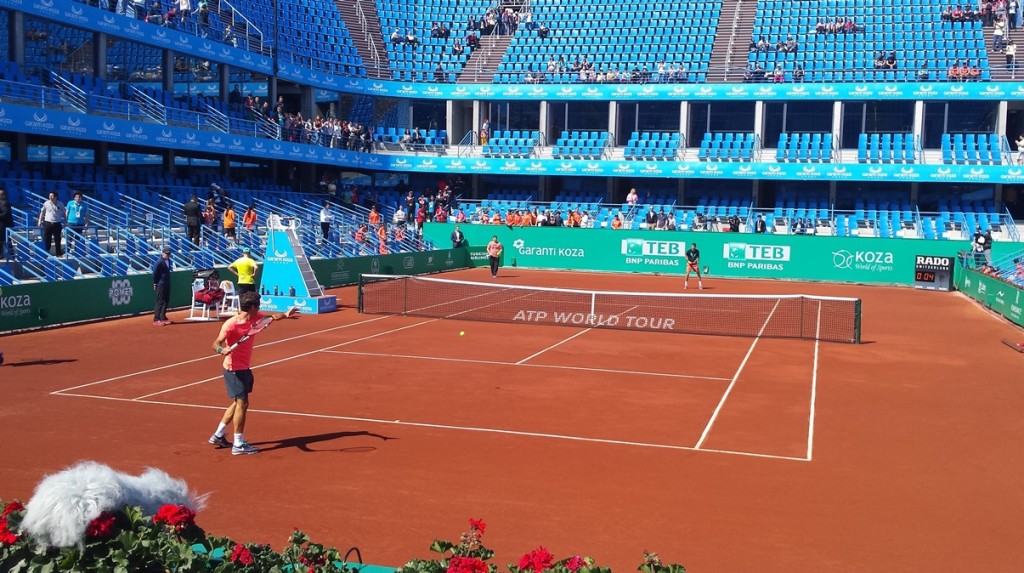
Part 2: And Yet…
Unfortunately, the tournament’s day-to-day operational problems, and the inadequacy of the facilities do not live up to the excitement that the pre-tournament announcements had generated. Let’s first start by the arrival to the tournament. If you are driving, at most ATP and WTA Tour events, the signs pointing everyone in the right direction begin from miles away, sometimes at the first exit that you take from the nearest major highway. Here, not only are there NO SIGNS anywhere at all in traffic to guide you to the venue, but once you arrive to it, there are no signs indicating the location of the entrance, and furthermore, the entrance itself does not correspond one bit to the type of entrance that one would expect from a tour event. See the two pictures below and judge for yourself:
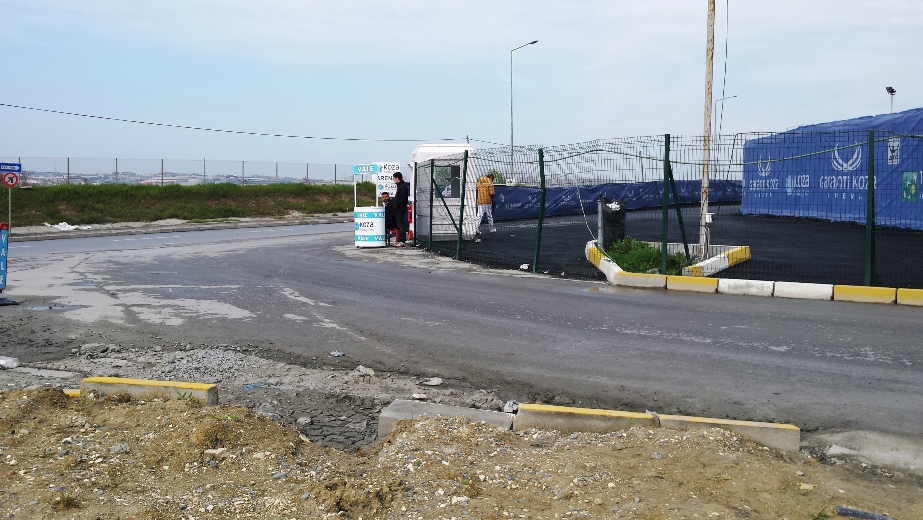
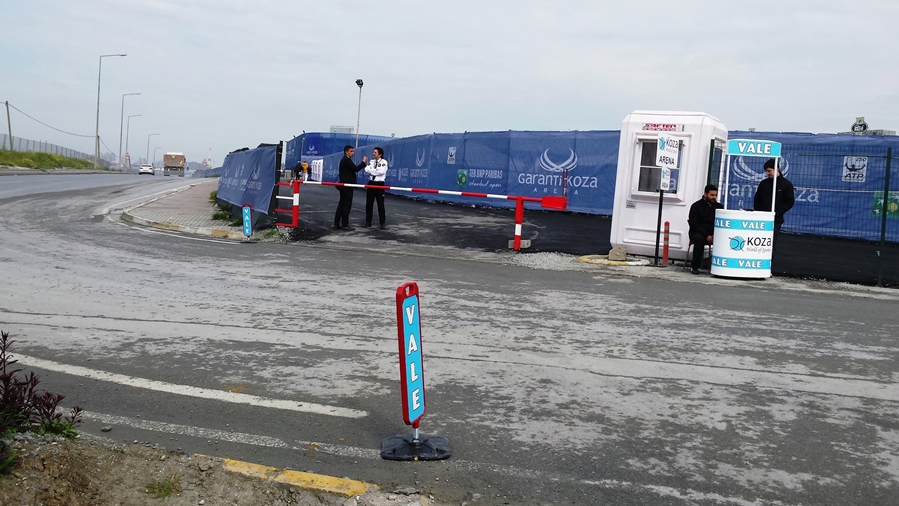
So, if you are driving and you arrive to the above so-called “gate”, it is likely that you will simply keep driving, thinking that the real entrance must be coming up elsewhere, except that it never does. You can’t turn around either because the road is a one-way traffic, thus you end up driving around another 10-15 minutes just to find your way back to the so-called entrance that resembles the back alley entrance of a wholesale store in small town USA. There is no transportation arranged to the tournament site from any of the major populated areas in Istanbul, and yes, considering that the tournament’s location is far outside Istanbul, that is a handicap. One can use public transportation to get close to the tournament, and then walk to it in about 10 to 20 minutes, but once again, there will be no signs indicating them where to turn, how to find the entrance, etc.
Once you walk in the venue, you are treated to the sounds of repair tools, and to stands and tents that are still in a state of construction. There is literally construction noise that you cannot avoid. Just to clarify, this is happening on the weekend of qualifying matches. Main draw matches begin Monday and some preparations are still not complete; one hears hammers and drilling at various spots. There is only one food provider and the prices on its menu basically scream “Yes! You are tennis fans, thus you have money by default, and yes, we are here to milk it with grossly overpriced menu items”!
The area surrounding the tournament venue, is full of construction, and quite frankly, ugly! How ugly? Look at the picture below.
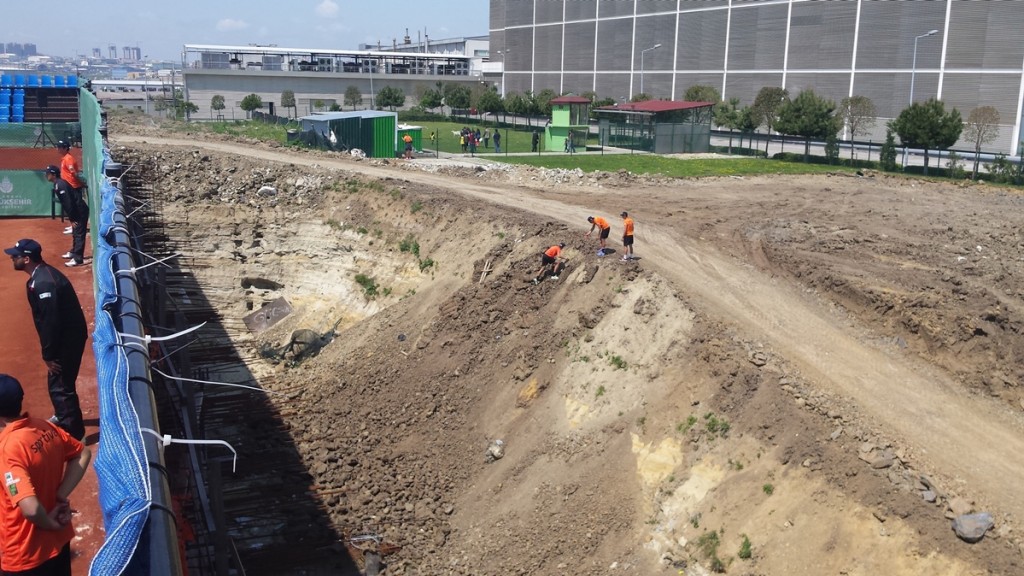
What you also notice on the picture are three ball boys, with two of them standing on top of the stony and dusty hill, one climbing up toward to the two other, with a racket in his hand. Here is the back story: Nikola Mektic loses to Thanasi Kokkinakis and chucks his racket outside the court in frustration. He may not have realized that there was big construction drop right behind the court, but that is not the point. The racket flies down all the way to the bottom where there are literally iron bars sticking out. Obviously, someone in charge asked the ball boys to go and fetch the racket. While I was watching them from a distance, my heart was heavy because I could only imagine the danger if the ball boy lost his footing and started to fall down (see again, the picture above)! Then, I noticed Mektic watching them from the top of the building on the other side with one other person (his coach?) and literally smiling and chatting. I got somewhat mad; mad at Mektic for throwing his racket and not telling the ball boys to forget it when he realized how dangerous the area where his racket ended up was, and mad at the person, whomever it may be, who initially told the ball boys to go and fetch the racket. And the fact that Mektic and his friend/coach clapped the boys when they finally retrieved the racket did not ease my frustration with the whole scene. Very few people witnessed the sequence. I certainly hope that this write-up will bring awareness to it, and those who are in charge will do what is necessary to avoid this type of fiasco.
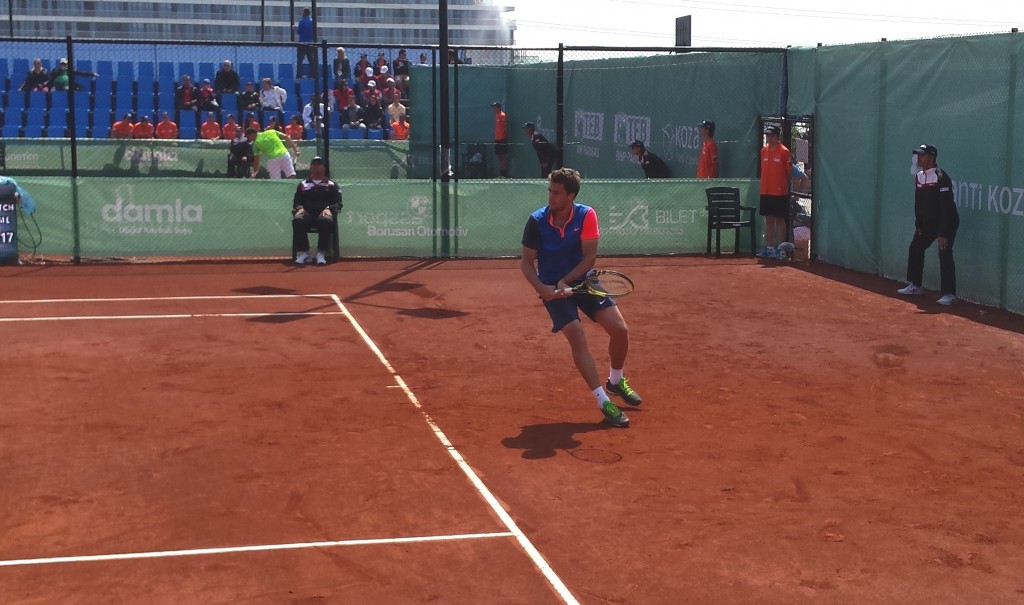
There are not many stands in the area where fans can stand and socialize outside the courts; moreover, there is hardly any covered space in case of rain! Beware those spectators who come without an umbrella. Also to the spectators who desire to watch a match on Court number 3: sorry folks! It’s simply not possible. You can’t believe it? Let me explain in clear words: there are NO spaces (yes you read correctly, none!) planned for the spectators to watch a match court. You don’t believe me? See this picture:
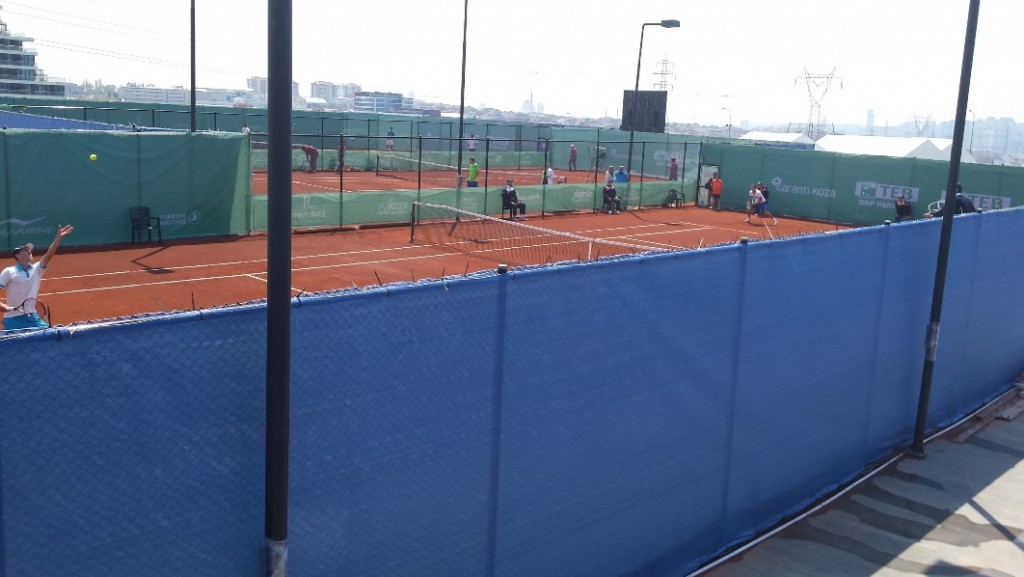
Your eyes are not deceiving you. There is actually an ATP Tour event that allocates matches to a court where there is literally NO possibility of it being seen by spectators. That couple that you see standing on the next court, and watching, happen to be the parents of one of the two players in action, thus an exception is made for them to stand on the side of the next court where there are other players practicing.
Courts 1 and 2 have stands indeed, but only one entrance each, through a small door on one side. There are no passages in the middle, no door on the other side. If you are a seasoned spectator at tournaments, you can imagine what mayhem that already caused in the qualifying rounds: spectators accumulating on the inside by the door to get out, while the ones waiting outside accumulate to get in! As one expects, there were many times where there was just enough time for the inside spectators to get out and not enough to let the outside ones in. Players had to wait after the game change while the referee kept yelling in vain “Time”, “Please sit down, players are ready to play,” or “Please don’t let anyone in.” At one time you even had the person responsible of lifting the chain (obviously with no clue how a tennis match works) at the door letting the outside people in, while the ones inside could not get out and accumulated right there. Players walked to the court to play the first point, referee kept yelling at the thirty or so people who couldn’t get out and at the thirty or so who just walked in, to sit down. One fan waiting to get out yelled back at the referee in English to make sure next time that the ones inside should get out first before letting the others walk in (which really should have been directed at the person lifting the chain who probably speaks no English). You get the picture…
Speaking of outside courts, one court suffered surface problems during a match, which caused the players to move to center court to resume their encounter on Saturday (originally, no matches were scheduled on center court on that day).
Let’s now move to the center court which should be the jewel of the tournament. Yes, it is the largest tennis arena in Turkey (see below):
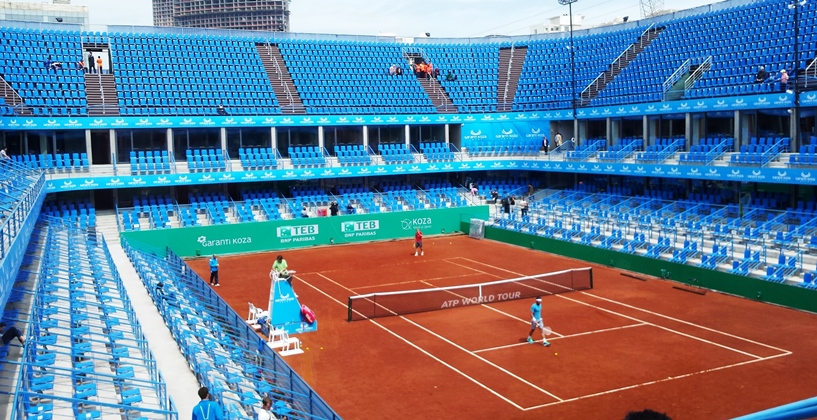
But again, that should not stop anyone from pointing to its faults. The upper stands are extremely steep and the steps not large enough for safety. The bars at the bottom are not tall enough either (see the picture below).
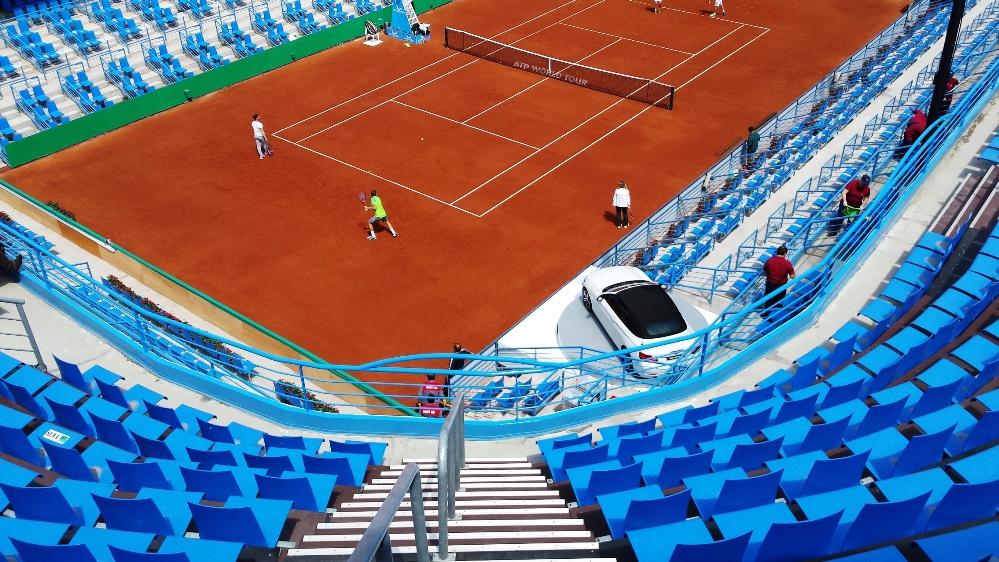
Thus, if anyone were to tumble and fall at the top, they would surely end up falling all the way to the bottom which presents a safety issue. When the stadium is filled to capacity (8,000 people), you will have fans hurrying up and down those stairs during game changes, and I do not dare to think any further. The media room is set up at the lower level, with its entrance directly giving way to the stairs, only several meters from the court. In other words, the media people will be walking in and out while the players on center court are playing a match. Did nobody know that the main entrance to the media room should always be from the outside of the court not by the court itself? Imagine this possible scenario on Saturday: Dimitrov wins his semifinal match, and Federer begins his semifinal. At that time, Dimitrov comes to the media room to hold his after-match press conference. How will they keep the tranquility at the entrance of the media room with journalists running in and out of the room (rightfully so, to get to the press conference) and people perhaps wanting autographs from Dimitrov while Federer’s match is being played close by with the capacity 8,000 people watching?
I must point out that the organizers had good intentions. For example, they brought in from Roland Garros two clay-court specialists to prepare the courts and supervise them. They successfully attracted top names to the tournament. They successfully found sponsors. The tournament directors have experience. But it’s hard to avoid inefficiencies when you have generals with no army, and no coordination. I witnessed myself the French clay-court expert complain about the workers allocated to him, that they have never seen a tennis court in their lives (as he was saying this, the men were watering the backdrops and the advertisements, before he yelled at them that their job was to water the court and not what is around it!!). Unfortunately, the concept of “preparations done on time” was not on the radar. In this article, I talked about some major inadequacies, yet there were many minor ones too, such as the electronic scoreboard outside on the grounds to inform spectators of the scores and the match schedule not working (yet).
There is one excuse that everyone keeps hearing: “This is the first time an ATP event is organized so some problems should be expected”. No, sorry that does not wash my friends! The fact that an ATP event in Istanbul is a first, yes it’s correct; but that a tennis event of this magnitude is something new to Istanbul is utterly incorrect! Istanbul Cup, the WTA event, has been held since 2005, and last year’s edition was held precisely at this same venue. Istanbul hosted WTA year-end championships three years in a row with much success. Adequate measures should have been taken on time. “We could not foresee this (or that)” is simply not an acceptable sentence!
My upcoming articles this week will focus a lot more on the matches and on tennis. However, these problems must be pointed out to anyone who is open to criticism. Hopefully, when next year’s tournament takes place, I can write about how the organization has improved and what a treat the tournament has become for the fans due to its efficient management. For this year, Roger Federer’s appearance may have saved the day, but you can’t bring a Federer each year to save the day.
Starting tomorrow, it’s main draw time:
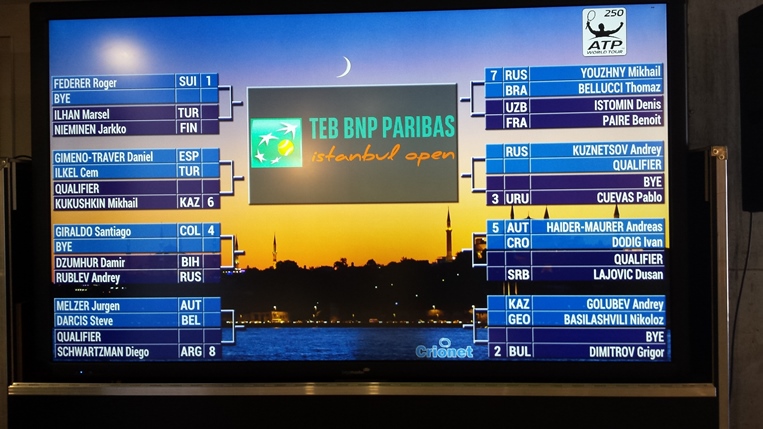
Live updates on Twitter: @MertovsTDesk
